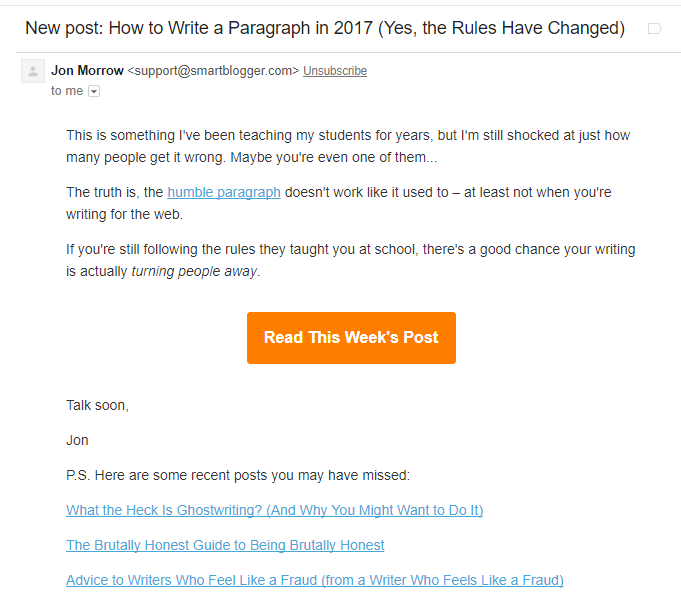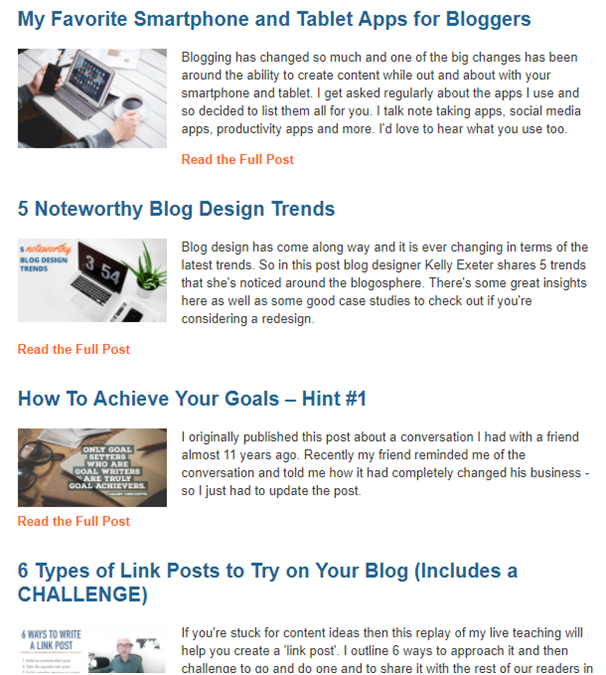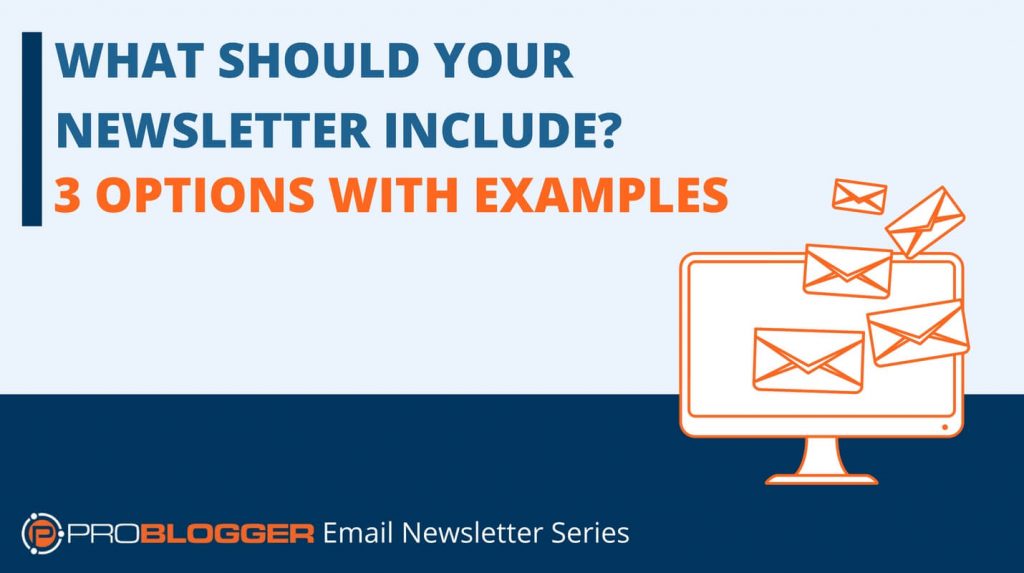This post is part of our Email Newsletter Series
So we’ve convinced you that you need a newsletter, Or maybe you already have a mailing list set up and ready to go.
Now, what should you send your readers?
A lot of bloggers struggle with what to include in their newsletter. Unfortunately, it often leads to them emailing only occasionally – or not at all.
If you subscribe to other people’s newsletters then you’ll know they’re all unique. But chances they all fall into one of three main categories.
Type #1: Exclusive Content Written Especially for the Newsletter List
Some bloggers use their newsletter to send content that doesn’t appear anywhere else.
This can be a great way to make readers feel they’re receiving something exclusive and valuable, as well as share ideas that might not work in a full-length blog post.
Example: Planning with Kids
Nicole Avery, our productivity expert from Planning with Kids, does this with her newsletter. Here’s an excerpt from her recent mailout titled “The danger of future planning”:

This is just the start of the article. Nicole goes on to show a photo of her own to do list, and explains how her planning process helps her “stay in the moment”.
Tip: Because you’ll be writing content for both your blog and your newsletter, you might want to consider using an editorial calendar for your blog and newsletter to keep them both on track.
Type #2: Blog Posts Sent Out by Email
Some bloggers use their newsletter as an email subscription to their blog. They may send out full posts, or short “teasers” plus a link to each post.
If you’re short on time, this is a good way to go.
Example: Smart Blogger
Jon Morrow from Smart Blogger argues strongly for this type of newsletter. And his own newsletter is a good example of one:

You can see how short Jon’s newsletter is. He doesn’t include the post itself. Instead, he really sells it to the reader. And instead of a link to click on he has a big orange button that stands out.
Tip: Like Jon, you can include links to other recent posts, or even posts from your archives that you want to promote. This can help get click-throughs from readers who aren’t interested in your current topic, but who might enjoy something else you’ve written.
Type #3: Weekly (or Monthly) Digest
If you publish several posts a week like we do, you don’t want to be emailing your readers every time one goes up. They may well unsubscribe due to the sheer volume of emails.
Many larger blogs offer a weekly digest – a weekly email with links to all the posts from that week. Which is exactly what I do on ProBlogger and Digital Photography School.
Example: ProBlogger
Here’s the email I sent out a few weeks ago:

As you can see, for each post I include the title, the feature image, a short description and a link to read the full post. Readers can also click on the image or title to go straight to the post.
Tip: If you don’t want to write a summary for each post, you could quote the first couple of sentences or even pull out a key point from later on in the post.
Structuring Your Email Messages
Unless you’re sending out full blog posts (and nothing else), you’ll need to think about the structure of your messages.
While many bloggers include different types of content, the newsletter will still probably have a main focus such as a weekly round-up or an exclusive piece of content.
You could include:
- an introduction, which might involve industry or personal news
- links to useful resources, such as your own posts or other people’s posts
- A promotional message that mentions one or more of your products/services.
Look through the newsletter you receive, or even subscribe to extra ones, and see what they include. Think about what works for you as a reader. Which newsletters do you enjoy reading, or rarely bother opening?
As you think about structure, you’ll also want to consider the frequency of your emails. If you plan on emailing twice a week, you’ll probably need to send shorter messages than someone who emails once a month.
Other Emails to Send to Your Newsletter List
As well as sending out regular (weekly or monthly) newsletters, you’ll probably want to email your list with other types of content.
These occasional emails might include:
- A promotional sequence of launch posts
- An autoresponder to deliver a specific course or series
- An email designed to get feedback from your readers
#1: Promotional Emails
When you launch a new product/service (or run a sale on an existing one), you definitely want to let your email subscribers know about it.
And not just once.
As we discussed last week, emails typically result in more sales than other channels such as social media. So make the most of it.
Some bloggers worry that readers will unsubscribe if they receive any promotional emails. This isn’t true. In fact, some readers may may have signed up specifically to find out when you release something new (or drop the price on something you already have).
Naomi Dunford of IttyBiz wrote about this recently in What I Learned Deleting 16,282 Names From My List (By Hand).
Obviously, you need to find a balance. Receiving an email every day during your 14-day launch may be too much for even your most dedicated subscribers.
#2: An AutoResponder
I talked briefly about autoresponders last week. They can be a great way to bring new newsletter readers up to speed and provide real value by helping them learn a new skill, tackle a problem, or move forward in their life.
You can also set up an autoresponder for readers who’ve been around for a while. Most bloggers do this by letting readers opt in to the autoresponder separately. Long-term readers may not be thrilled if you suddenly plunge them into a four-week email course they didn’t sign up for – no matter how great the content is.
#3: Getting Feedback
Email can be a great way to get feedback from readers who may never comment on your blog. Simply ask a question, and encourage them to reply. (Some bloggers do this with their “Welcome” email, or an early email in their autoresponder sequence.)
If you want structured feedback to several questions, you can use SurveyMonkey or Google Forms to construct a survey. You can then email readers to tell them about the survey and encourage them to fill it in. (To encourage your readers to respond, you could offer a small freebie or a prize draw for everyone who takes part.)
I’m sure there are plenty of other options I haven’t covered here. So if you’re doing something a bit different with your list, or if you’ve spotted a blogger using email in an unusual and effective way, let us know in the comments.
But remember, there’s no “right” way to do newsletters. Many bloggers experiment with lots of different options. What’s most important is that you start.
Decide what sort of newsletter you’re going to send out (exclusive content, blog posts or weekly digest), come up with a straightforward format, and then stick with it for a few months to see how it goes.
And let us know how it goes.
